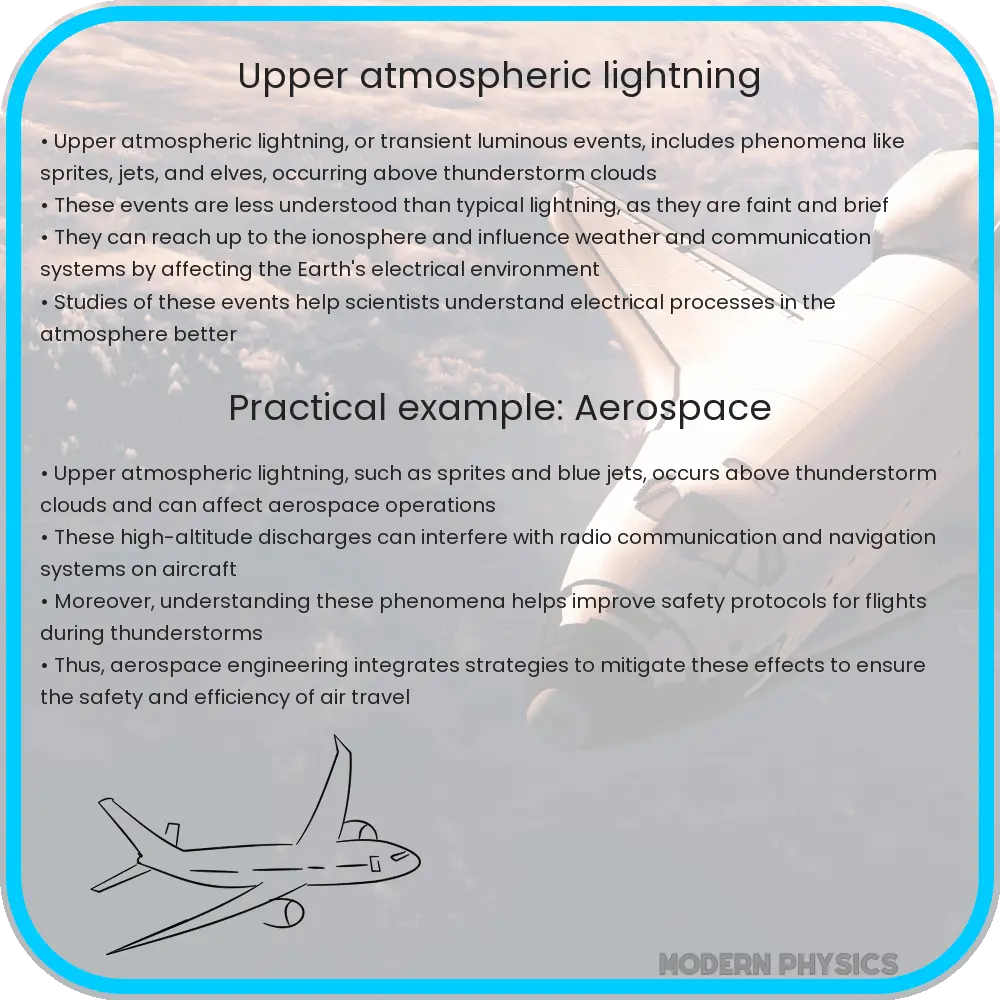Learn about upper atmospheric lightning, including captivating phenomena like sprites, elves, and blue jets, occurring above severe storm clouds.

Upper Atmospheric Lightning: Mystery, Spectacle & Science
Upper atmospheric lightning presents an enchanting display far above the thunderstorms that we typically associate with lightning. And although these high-altitude phenomena have been observed for decades—both by pilots and ground-based observers—it wasn’t until the late 20th century that scientists began to study them systematically. Known by their captivating names like sprites, elves, and jets, upper atmospheric lightning not only offers a visual spectacle but also a realm ripe for scientific exploration.
An Overview of Upper Atmospheric Phenomena
Unlike the more familiar lightning, which occurs within and below the clouds, upper atmospheric lightning encompasses several types of transient luminous events (TLEs) that occur well above storm clouds. The major types include:
- Sprites: These are perhaps the most well-known type of TLEs. Sprites are large-scale electrical discharges that occur high above thunderstorm clouds, typically between 50 to 90 kilometers altitude, often appearing as a series of vertical red columns. They are sometimes accompanied by blue tendril-like structures.
- Blue jets: These are cone-shaped discharges of blue light that emanate from the tops of storms and can reach up to about 40 to 50 kilometers into the atmosphere.
- Elves: Short for “Emission of Light and Very Low Frequency Perturbations from Electromagnetic Pulse Sources,” elves are rapid expansions of glowing rings in the ionosphere (at around 90 kilometers altitude), triggered by the electromagnetic pulse from a lightning strike below.
The mesmerizing visuals of these phenomena have not only piqued the curiosity of onlookers but have also challenged the scientific community to unravel their mysteries.
The Science Behind the Spectacle
To understand how these spectacular shows occur, it’s important to delve a bit into the science of thunderstorms and the atmosphere. Thunderstorms are powerful engines driven by the movement of moisture and heat. When conditions are right, they generate not only rain and lightning but also affect the layers of the atmosphere above them.
The regular lightning that we see in a thunderstorm—known scientifically as intra-cloud or cloud-to-ground lightning—plays a pivotal role in the genesis of upper atmospheric lightning. It is the strong electric fields generated by these energetic storm events that lead to the initiation of the various forms of upper atmospheric lightning. Specifically:
- Sprites usually occur milliseconds after a particularly strong lightning strike that lowers a large electrical charge to the Earth’s surface.
- Blue jets are believed to originate from electrically-charged regions within the storm clouds themselves.
- Elves occur almost instantaneously with the lightning strike due to the rapid spreading of electromagnetic energy.
Understanding these phenomena not only adds to our knowledge of atmospheric sciences but also helps in monitoring the climatic impacts of severe weather events.
Observation and Detection Techniques
Observing upper atmospheric lightning poses significant challenges due to its transient nature and high altitudes. Initial observations were often serendipitous, typically by pilots, and not until the advent of high-speed cameras and advanced sensors could these events be methodically captured and studied.
Nowadays, scientists utilize a variety of tools to observe and record upper atmospheric lightning. These include:
- Space-based platforms: Satellites equipped with optical sensors provide valuable data on TLE occurrences globally, enabling a better understanding of their distribution and frequency.
- Ground-based photometric arrays: These systems consist of multiple cameras that capture the fast transients of upper atmospheric lightning at different wavelengths, allowing detailed analysis of their properties.
- High-speed cameras: Capable of recording tens of thousands of frames per second, these cameras can capture the split-second events that constitute upper atmospheric lightning.
Together, these tools help demystify the processes occurring far above our usual gaze, deepening our understanding of the atmospheric phenomena tied to the planet’s weather systems.
The Role of Upper Atmospheric Lightning in Earth’s Ecosystem
While it’s clear that upper atmospheric lightning forms a spectacular visual display, its implications for Earth’s ecosystem are profound and multifaceted. These high-altitude electrical phenomena play a crucial role in the chemical processes of the upper atmosphere, particularly in the formation and modification of the ozone layer. This layer acts as a protective shield absorbing and scattering the solar ultraviolet radiation that is harmful to life on Earth.
- Sprites are known to affect atmospheric chemistry by producing nitric oxide (NO), which can alter the concentration of ozone in the upper atmosphere.
- Blue jets and Elves also contribute to these changes, though their exact impact is still under investigation.
The ongoing research into these phenomena enhances our understanding of atmospheric dynamics and may lead to improved models for weather prediction and climate monitoring.
Future Research and Exploration
Despite significant advancements in the understanding and observation of upper atmospheric lightning, there remains much to uncover. Future research will focus on better characterizing the physical mechanisms that drive these phenomena, their impact on global electromagnetic and chemical processes, and their interactions with other atmospheric components.
Funding and collaboration across countries and disciplines will be vital in advancing our understanding. With improved computational models and detection technologies, researchers hope to unlock the secrets of upper atmospheric lightning further, potentially leading to breakthroughs in environmental science and meteorology.
Conclusion
Upper atmospheric lightning continues to fascinate both the scientific community and the public with its majestic and mysterious nature. Through continued research and sophisticated observation techniques, we deepen our understanding of the complex interactions within Earth’s atmosphere. This not only solves puzzles about the phenomena themselves but also enhances our broader understanding of global weather patterns and environmental protection. By unveiling the secrets of the skies above us, we can foster a greater appreciation for the intricate systems that sustain life on our planet and better prepare ourselves for the future.
